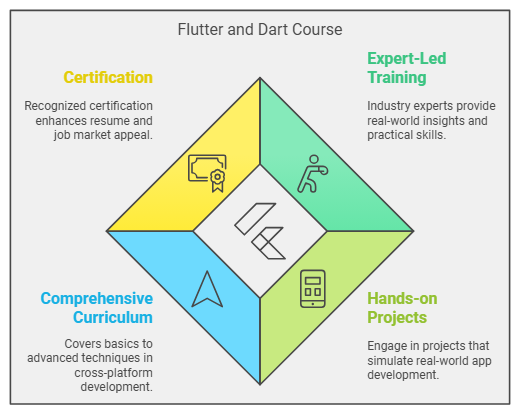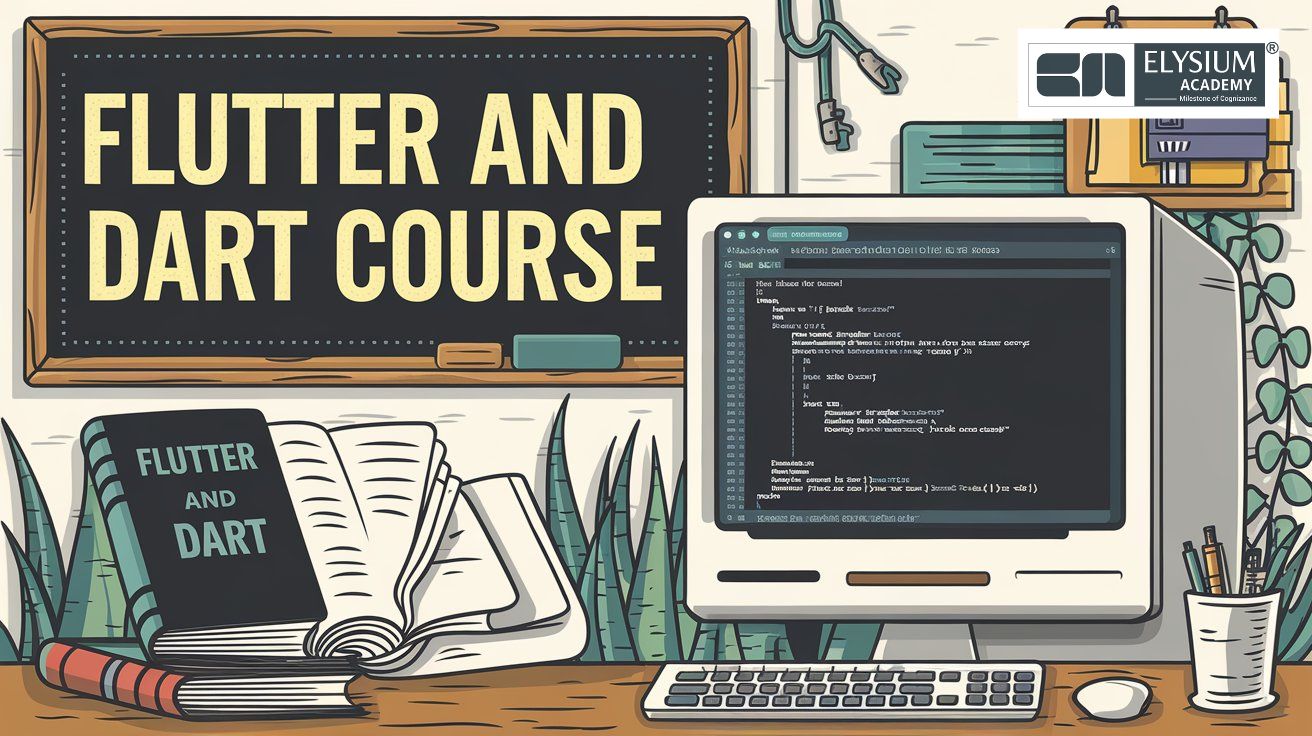Mobile app development is constantly evolving, driven by the need for apps to function seamlessly across multiple devices and platforms. For businesses, this means investing heavily in maintaining different versions of their apps for both Android and iOS. However, with the rise of powerful cross-platform frameworks like Flutter and Dart, this process has become much simpler, efficient, and cost-effective.
If you are looking to overcome the hurdles of cross-platform development, enrolling in a Flutter and Dart course at Elysium Academy is a smart move. This guide will dive deep into how mastering Flutter and Dart can help you conquer cross-platform challenges and advance your career as a proficient app developer.
Understanding Flutter and Dart
Before we explore how Flutter and Dart Course can solve your cross-platform development woes, let’s understand what these technologies are.
What is Flutter?
Flutter is an open-source UI toolkit developed by Google that allows developers to create beautiful, natively compiled applications for mobile, web, and desktop from a single codebase. It is gaining popularity due to its ability to deliver high performance and visually appealing apps that run on multiple platforms with a single codebase.
What is Dart?
Dart is the programming language used by Flutter. Created by Google, Dart is designed to be simple, efficient, and scalable. It compiles to native machine code, which enables Flutter apps to run quickly and smoothly. Dart’s syntax is easy to pick up, especially for those familiar with JavaScript or C-style languages.
The Key Challenges in Cross-Platform Development
Developing apps for multiple platforms is no longer an option but a necessity for businesses aiming to reach the widest possible audience. However, traditional mobile development approaches often involve maintaining separate codebases for Android and iOS, which can be cumbersome and costly. Let’s take a closer look at the specific challenges that developers face in cross-platform development of Flutter and Dart course:
- Multiple Codebases
The most significant challenge of traditional mobile development is maintaining two distinct codebases—one for Android, written in Java or Kotlin, and another for iOS, typically written in Swift or Objective-C. Each platform has its unique architecture, design guidelines, and best practices. This Flutter and Dart course means developers need to replicate functionalities, fix bugs separately, and ensure that both versions are in sync. The doubled effort can lead to increased project timelines, higher costs, and more chances for errors. - Device Compatibility
Ensuring that your app works flawlessly on a wide range of devices is another major challenge. Android devices, in particular, vary widely in terms of screen sizes, hardware specifications, and OS versions. While iOS has fewer variations, Apple introduces new device sizes and features regularly, which adds complexity. The need to test and optimize apps for each device and OS version makes cross-platform development time-consuming. - Design Consistency
One of the biggest hurdles is maintaining a consistent user experience across different platforms. iOS and Android have distinct UI/UX guidelines, which can lead to discrepancies in app design when using traditional frameworks. Developers often need to invest extra time to tweak designs so that the app feels native on each platform, which can further delay the release cycle. - Performance Optimization
Cross-platform frameworks often rely on rendering web components or using abstraction layers, which can lead to slower performance compared to native apps. Achieving smooth animations, fast load times, and responsive interactions can be challenging, especially when building complex applications. The lack of direct access to native APIs can also limit what the app can do, impacting its overall performance. - Time-to-Market
Since developing and maintaining separate codebases takes a lot of effort, it can drastically increase the time it takes to launch an app. This delay can be critical for businesses aiming to capture market trends or respond to user demands quickly. The longer development cycles can lead to missed opportunities and reduced competitiveness.
How Flutter Addresses Cross-Platform Development Issues
Flutter, Google’s open-source UI toolkit, has emerged as a robust solution for overcoming these cross-platform challenges. By enabling developers to write a single codebase that runs on multiple platforms, Flutter significantly reduces development time and effort. Here’s how Flutter and Dart course excels:

- Single Codebase for Multiple Platforms
With Flutter, you only need to write code once to deploy it across iOS, Android, web, and even desktop platforms. This unified approach means that developers can reduce their workload, cut down on development time, and avoid duplicating efforts. The efficiency of having a single codebase also simplifies the process of fixing bugs and adding new features, ensuring consistency across all platforms. - Hot Reload for Instant Feedback
One of Flutter’s most celebrated features is its hot reload functionality. It allows developers to see changes made in the code almost instantly on the emulator or device, without losing the app state. This speeds up development by reducing the time spent on debugging and testing. The ability to experiment, build, and iterate quickly helps developers perfect their apps more efficiently. - Highly Customizable Widgets for Native Look and Feel
Flutter comes with a rich set of pre-built widgets that are highly customizable, allowing developers to create user interfaces that look and feel native to the platform. Whether it’s a Material Design theme for Android or a Cupertino style for iOS, Flutter’s widgets are designed to mimic native components closely. This ensures a consistent user experience while still leveraging the unique capabilities of each platform. - Native Performance with Dart
Unlike other cross-platform frameworks that rely on WebView or JavaScript bridges, Flutter compiles directly to native machine code using the Dart compiler. This ensures that apps perform at near-native speed, delivering smooth animations and quick load times. The direct compilation to native code also eliminates the lag often associated with other frameworks. - Powerful Animation and Graphics Support
Flutter’s graphics engine is built on Skia, which powers graphics for Google Chrome and Android. This allows Flutter to deliver complex animations, smooth transitions, and visually rich apps with ease. The built-in support for animation and graphics makes it ideal for apps that require an engaging and immersive user experience.
The Advantages of Learning Flutter and Dart Course
In today’s competitive tech landscape, developers who are skilled in Flutter and Dart Course are highly sought after. Here are some compelling reasons why mastering Flutter and Dart course technologies can give you a competitive edge:
- Future-Proof Your Skills
As more companies adopt Flutter for their app development needs, gaining expertise in this technology ensures that you stay ahead of industry trends. Google’s ongoing investment in Flutter suggests that it will continue to grow in popularity, making it a valuable skill for developers. - High Demand for Flutter Developers
With its ability to streamline the app development process, Flutter is rapidly gaining traction among startups and established enterprises alike. Many companies are actively looking for developers who can build cross-platform apps efficiently, leading to an increase in job opportunities and higher salaries. - Cost Efficiency for Businesses
Companies prefer using Flutter to reduce development costs and time-to-market. By mastering Flutter, you become a valuable asset to organizations that want to save on costs without compromising on quality. - Higher Salary Potential
Due to the specialized nature of Flutter development, professionals with these skills often command higher salaries. Whether you’re a freelancer or looking to join a tech company, expertise in Flutter can enhance your earning potential.
What You Gain from a Flutter and Dart Course at Elysium Academy
At Elysium Academy, Flutter and Dart course offer a comprehensive course that covers everything you need to know to become proficient in Flutter and Dart development. Here’s what you can expect from the course:

- Expert-Led Training
Our Flutter and Dart course is led by industry experts who have years of experience in mobile app development. They bring real-world insights to the classroom, helping you gain practical skills that you can immediately apply to your projects. - Hands-on Projects
Throughout the Flutter and Dart course, you’ll work on hands-on projects that simulate real-world scenarios. From building your first Flutter app to deploying it on the Google Play Store and Apple App Store, you’ll gain practical experience that will set you apart from other candidates. - Comprehensive Curriculum
The Flutter and Dart course covers everything from the basics of Dart programming to advanced Flutter techniques, including state management, API integration, and deploying apps. By the end of the course, you’ll have a strong grasp of cross-platform app development. - Certification
Upon successful completion, you’ll receive a recognized certification that validates your skills. This Flutter and Dart course can enhance your resume, helping you stand out in the job market.
Course Breakdown: Modules Covered
Our Flutter and Dart course at Elysium Academy is designed to be thorough yet flexible, allowing you to learn at your own pace. Here’s a breakdown of the modules you’ll cover:
- Introduction to Dart and Flutter: Learn the basics of Dart programming, setting up Flutter, and understanding the development environment.
- Flutter Widgets and Layout Techniques: Build stunning user interfaces with Flutter’s powerful widgets.
- State Management Solutions: Master popular state management techniques like Provider, Riverpod, and Bloc.
- Networking and API Integration: Fetch data from remote APIs and manage network requests.
- Working with Databases: Use SQLite and Hive for data persistence in your apps.
- Deployment to iOS and Android App Stores: Learn the best practices for deploying apps to both the Play Store and App Store.
- Building Web and Desktop Apps: Extend your skills by building apps that run on the web and desktop.
Comparison of Flutter vs Other Cross-Platform Frameworks
| Feature | Flutter | React Native | Xamarin | Ionic |
|---|---|---|---|---|
| Language | Dart | JavaScript | C# | JavaScript |
| Performance | High | Moderate | High | Moderate |
| Hot Reload | Yes | Yes | Partial | Yes |
| UI Components | Rich Widgets | Native Components | Native Components | Web Components |
| Learning Curve | Moderate | Easy | Moderate | Easy |
| Community Support | Growing | Large | Established | Large |
Frequently Asked Questions (FAQs)
1. Is Flutter suitable for beginners?
Yes, Flutter is beginner-friendly, especially if you have a basic understanding of programming. The course at Elysium Academy covers everything from the fundamentals to advanced concepts.
2. How does Flutter compare to other frameworks like React Native?
Flutter offers better performance due to its native compilation and rich set of customizable widgets, which often makes it the preferred choice for complex apps.
3. Will I receive a certificate after completing the course?
Yes, you will receive a recognized certification that can boost your resume and job prospects.
4. Do I need prior coding experience?
While prior experience in programming is beneficial, our course starts from the basics, making it suitable even for beginners.
5. What projects will I work on during the course?
In Flutter and Dart course, You’ll work on projects like a weather app, chat application, e-commerce store, and more, to give you hands-on experience.
Enroll Today to Transform Your Career
Elysium Academy Flutter and Dart course is your gateway to mastering cross-platform development. Whether you’re a beginner or an experienced developer looking to expand your skill set, this course provides all the tools and knowledge you need to excel. Don’t miss the opportunity to advance your career and become a sought-after Flutter developer!
Are you ready to master cross-platform development and become an in-demand Flutter developer? Elysium Academy Flutter and Dart course is designed to give you the skills, knowledge, and hands-on experience needed to excel in this field.
Don’t wait! Enroll Flutter and Dart course today to kickstart your journey in app development and transform your career!












